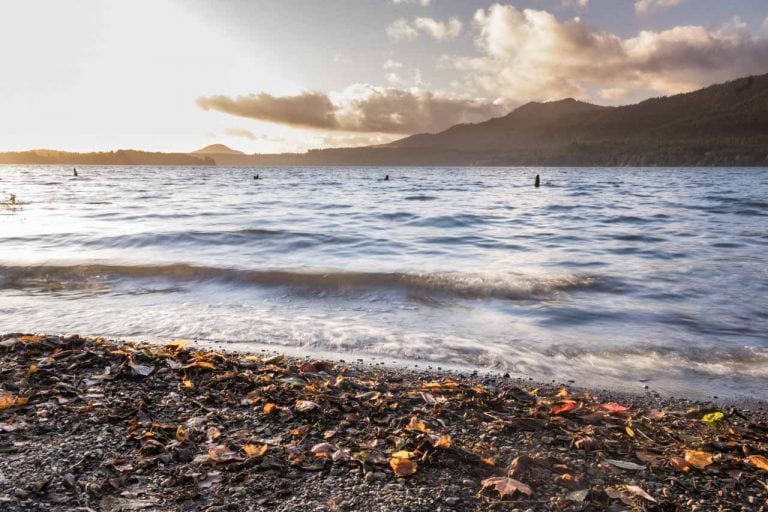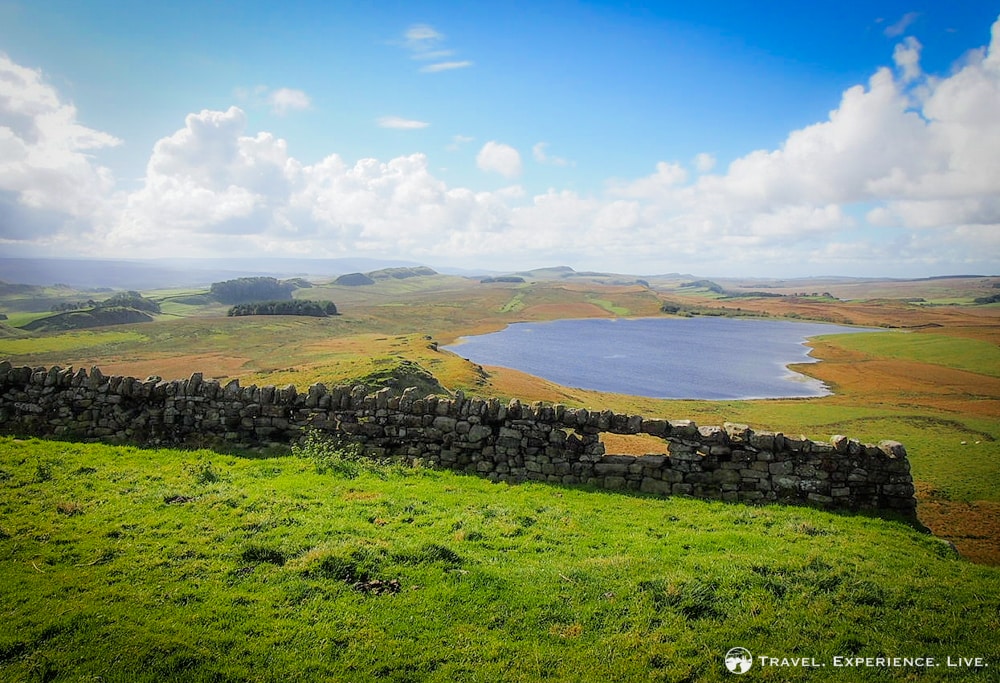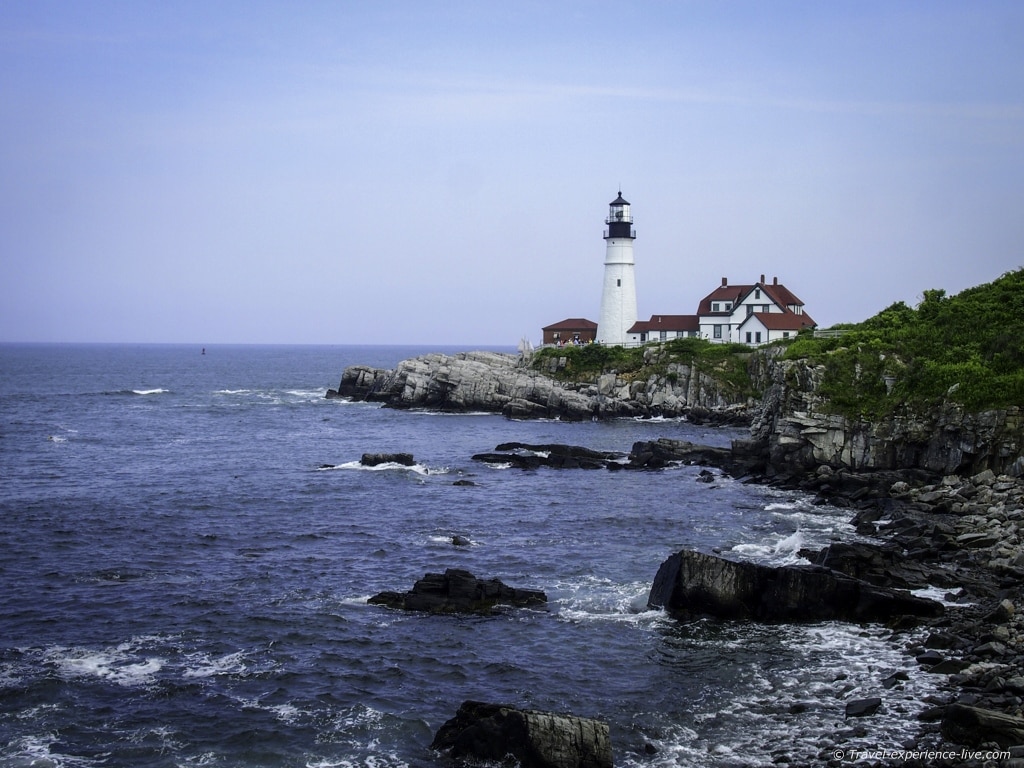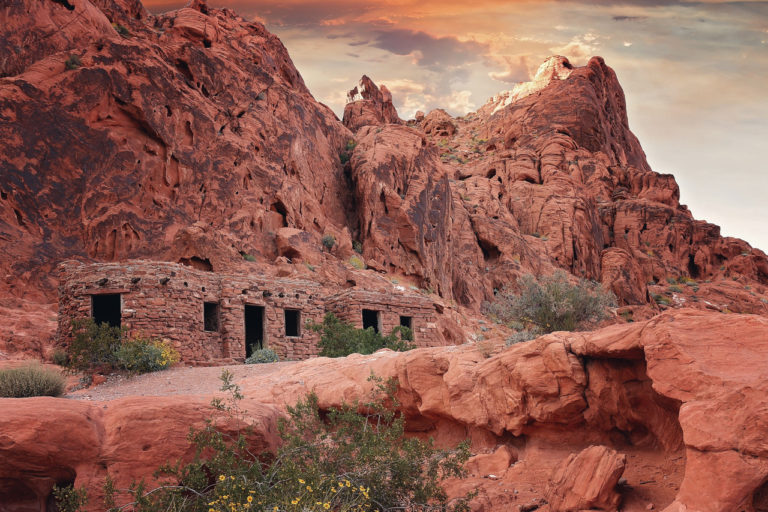Best Places to See Wildlife in Badlands National Park
Preserving one of America’s last remaining tracts of intact mixed-grass prairie, Badlands National Park is home to several iconic prairie animals. If you’re planning to do some wildlife watching during your visit to Badlands National Park, this guide will help you find the best areas to do that.
From the popular Badlands Loop Road to unpaved roads and hiking trails, it’s possible to encounter wildlife virtually anywhere in the park.
Although its name doesn’t sound particularly inviting, Badlands National Park encompasses one of the most interesting—and biodiverse—ecosystems in the wild American West.
For example, there are almost 60 species of grass in the national park, along with hundreds of wildflowers and forbs. These grasslands support a wide variety of animals, from tiny prairie voles and prairie dogs to bighorn sheep and massive bison, from toads and rattlesnakes to countless birds.
Several of America’s most iconic animals are present in Badlands National Park, offering unique wildlife viewing opportunities.
Even if you’re only spending a day in the park—I recommend at least two days, though—you should be able to see at least some Badlands National Park wildlife during your visit.
Wildlife viewing is, after all, one of the greatest things you can do in the Badlands!
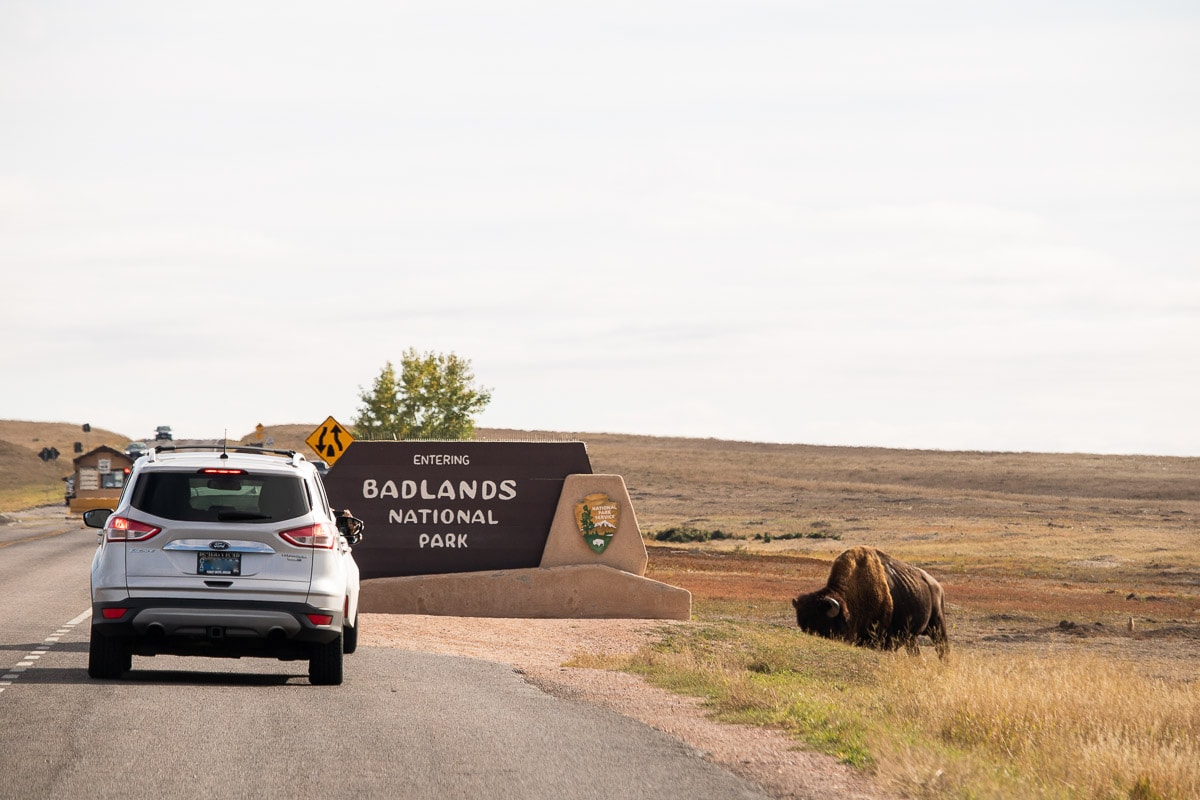
This blog post about the best places to see wildlife in Badlands National Park contains affiliate links. You can read more about our Terms of Use / Disclosure here.
Where to See Wildlife in Badlands National Park
Wildlife can be found literally anywhere in Badlands National Park.
Rattlesnakes sunbathe on trails, while hawks soar above. Industrious prairie dogs go about their social lives in their “towns”, pronghorn run across the prairie, as bison graze along roadsides. Bighorn sheep are in their element on the steep slopes of the Badlands. Mule deer munch on grasses.
Below, you’ll find an overview the most iconic wildlife in Badlands National Park and where to see them. This is the wildlife most visitors look for, the most “popular” animals if you will.
They’re also the “easiest” animals to see in Badlands National Park. With some patience, and a bit of luck, you might see all of them if you spend a couple of days in the park.
With the exception of rattlesnakes, I saw all of the animals highlighted below during my own two-day visit to Badlands, often more than once. I should note that I saw the most wildlife at dusk and dawn, including less commonly seen animals like coyotes, badgers and porcupines. So, you might want to consider getting up early for the best Badlands wildlife watching opportunities. (The sunrises in Badlands National Park are spectacular, too, so that’s a nice bonus.)
Remember, though, that there are literally dozens of other animals in this wildlife-rich park, too, including extremely rare species like the black-footed ferret.
American Badgers
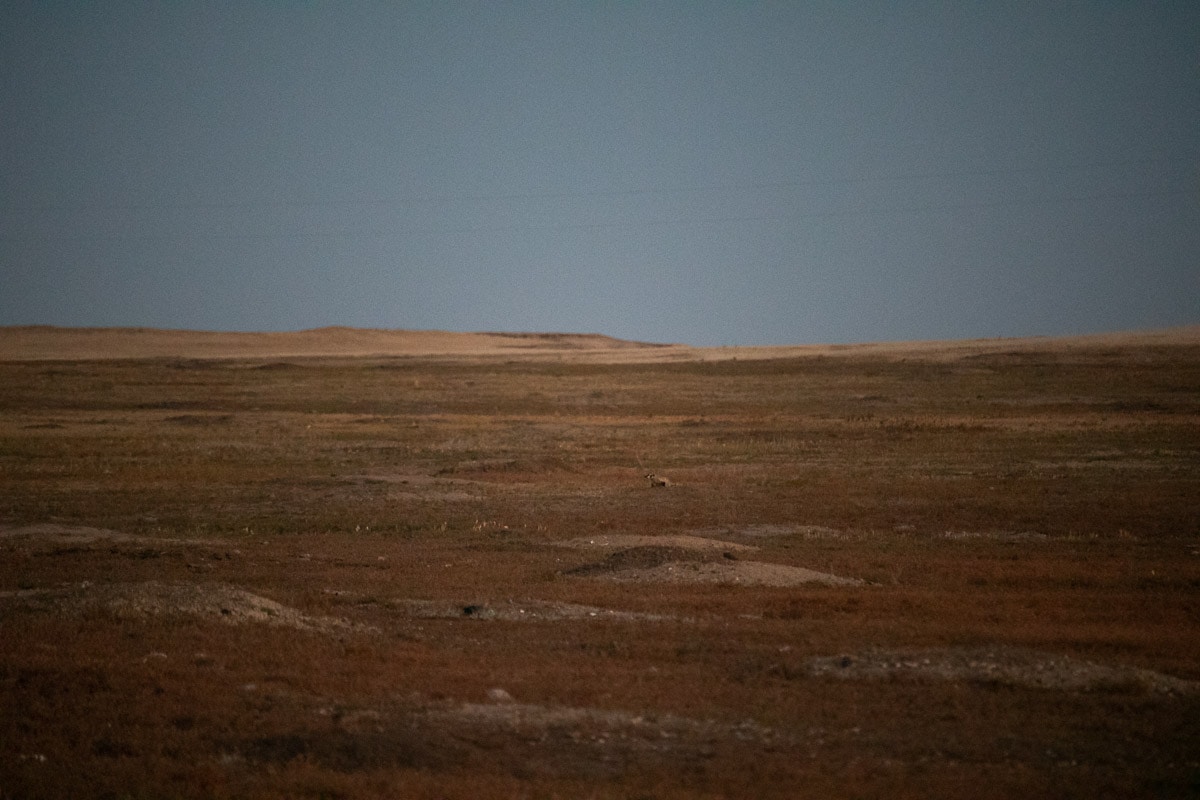
One of the more elusive mid-sized mammals in Badlands National Park is the American badger (Taxidea taxus). These mainly nocturnal animals can occasionally be spotted at dawn or dusk in the park’s open grasslands.
They feed on squirrels, mice, prairie dogs and even snakes, which makes the areas around prairie dog towns your best bet to see one. Look for them in the prairie along the Sage Creek Rim Road or around the Pinnacles Entrance Station.
American Bison
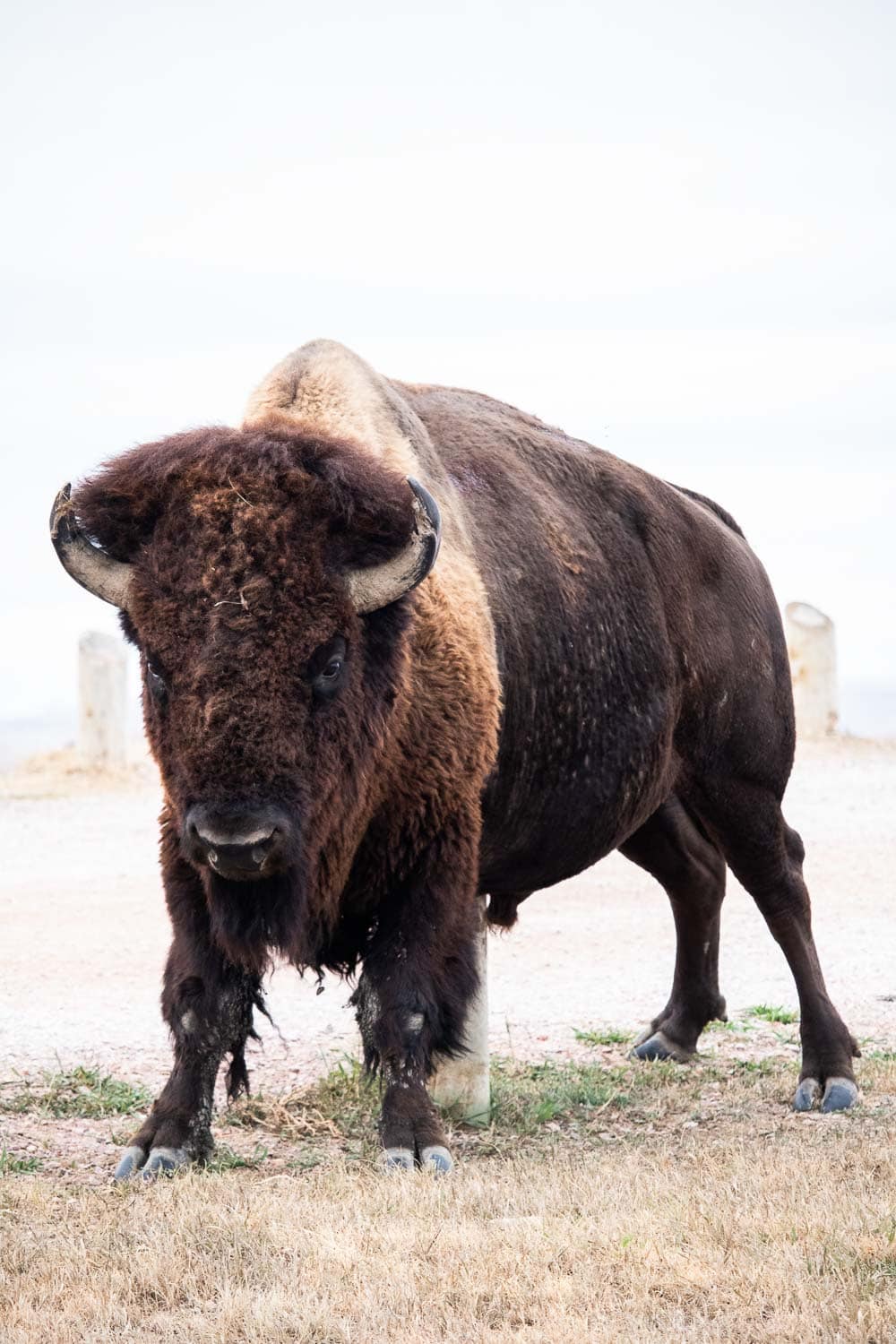
Also (incorrectly) called buffalo, millions of American bison (Bison bison) used to roam the sprawling American prairie before getting perilously close to extinction in the late-19th century.
Although they’re now once again present in the Badlands, they did have to be reintroduced here from nearby Theodore Roosevelt National Park in 1963.
Luckily, Badlands National Park’s sprawling mixed-grass prairie has helped the bison population to recover.
The park is in the heart of the bison’s historic range, an ideal environment for them to continue thriving (albeit under careful management). Nowadays, Badlands is one of only a handful of national parks where you can see bison in their native habitat.
The Badlands National Park bison herd consists of approximately 1,200 animals, one of the nation’s largest federally managed bison herds.
They’re mainly found in the western part of the North Unit, especially in the grasslands and on the slopes along the Sage Creek Rim Road. You can usually also see Badlands bison near the Pinnacles Entrance Station on the western part of the Badlands Loop Road.
Bison are surprisingly fast and can be dangerous. Badlands National Park regulations require all visitors to stay at least 100 feet away from bison, as well as all other animals. Learn more about bison safety here.
Bighorn Sheep
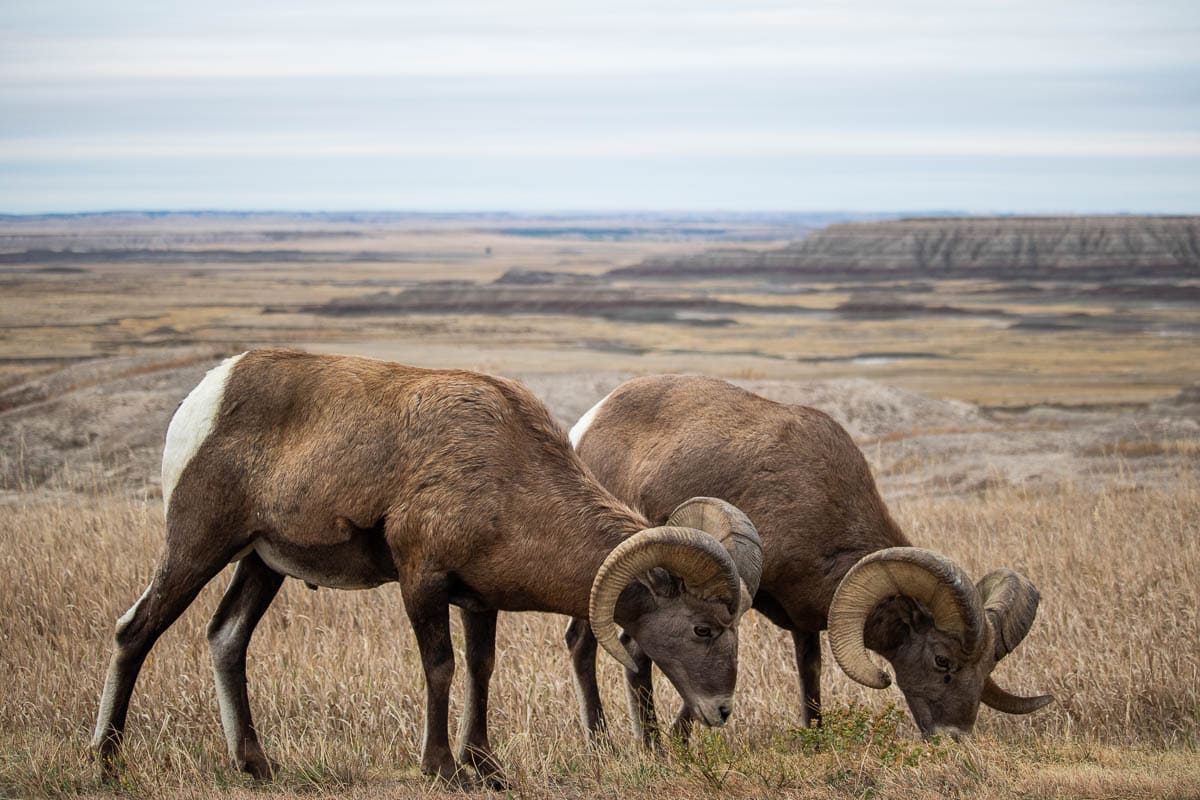
About 250 bighorn sheep (Ovis canadensis) currently call Badlands National Park home. These masters of the mountains are able to scale seemingly impossibly steep and rocky terrain, and are usually found on grassy slopes or in foothills below rocky buttes and cliffs.
This makes Badlands National Park, with its combination of rolling prairie, rugged ridges and sheer cliffs, the perfect bighorn sheep habitat.
These fascinating animals, named after the rams’ large, curved horns, live in (small) groups. It’s rare to see just one bighorn sheep—usually when you see one, there are others nearby.
In Badlands National Park, the best places to see bighorn sheep are some of the higher points and overlooks in Badlands National Park, such as the Pinnacles Overlook area (which is also spectacular at sunset), the Big Badlands Overlook and Cedar Pass.
You might occasionally spot them elsewhere along the Badlands Loop Road, too. Additionally, the Old Northeast Road is also a good area for bighorn sheep watching.
Coyotes
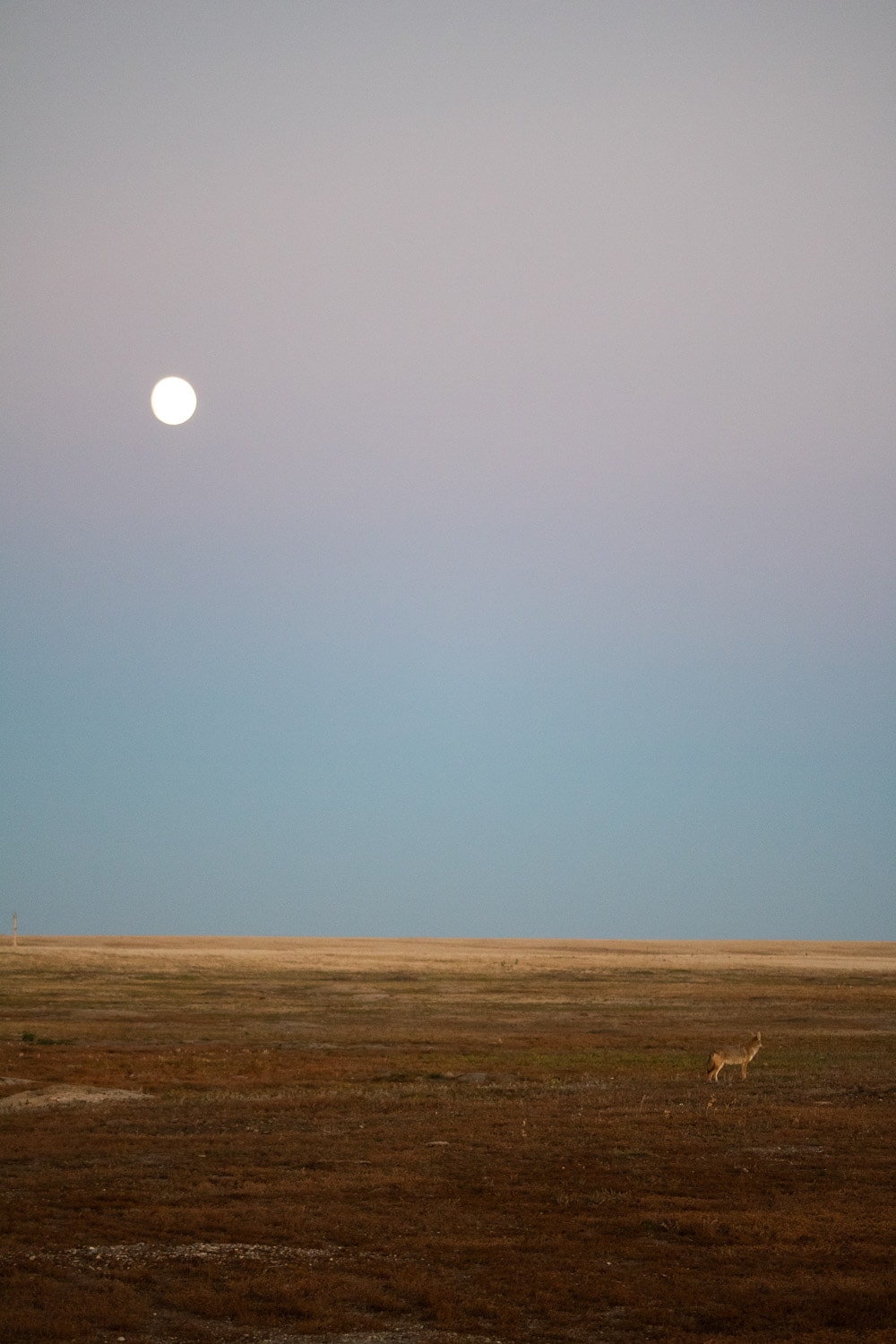
One of the most adaptable animals in North America, coyotes (Canis latrans) are as much at home in the rugged Badlands and prairie landscapes as anywhere else. In fact, this cunning canine was historically known as the “prairie wolf”, among other names.
Because their diet is mainly made up of rodents, rabbits, hares, deer and birds, coyotes have no lack of food sources in Badlands National Park. They feed on prairie dogs, prairie voles, chipmunks and mice, as well as on essentially all other animals they can catch.
Coyotes roam the grasslands of Badlands National Park and it’s hard to predict where you might be able to see them. That said, however, dawn and dusk are generally the best times to see them.
Look for them in the grasslands and prairie dog towns along the Badlands Loop Road, the Sage Creek Rim Road and at the Pinnacles Entrance Station.
Mule Deer
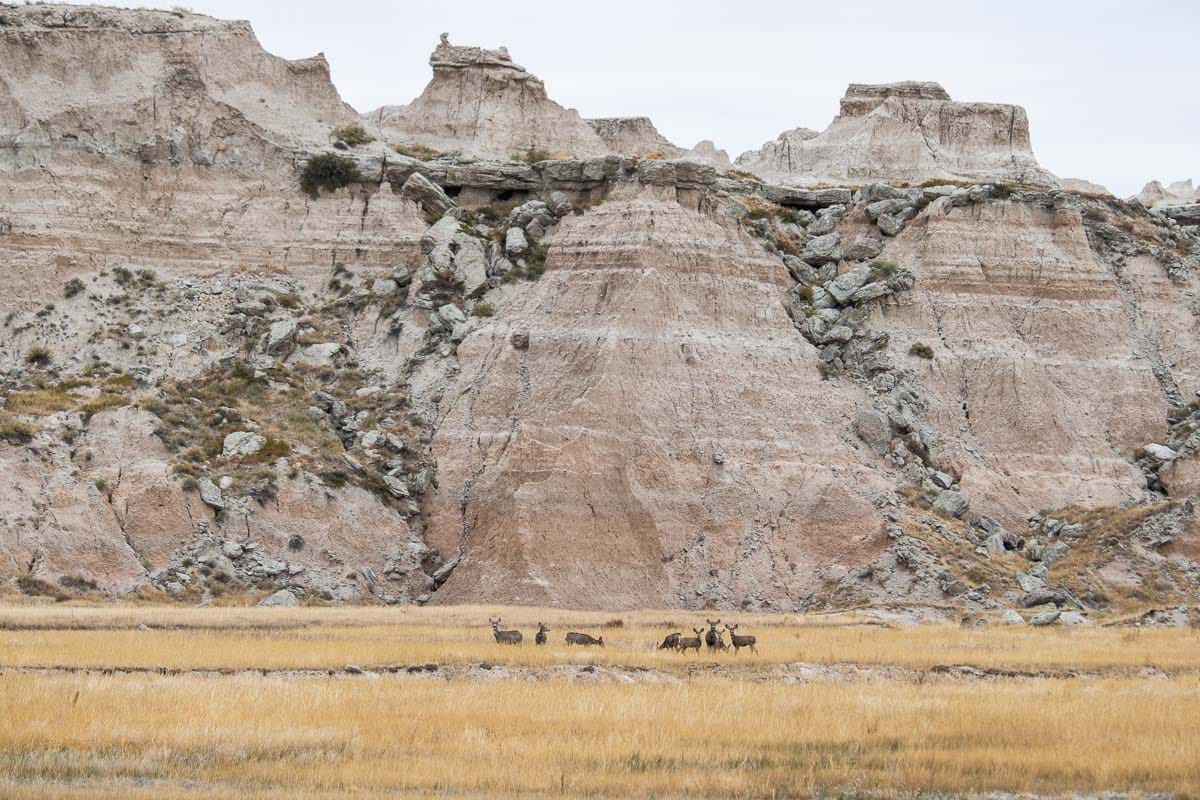
Native to the western Great Plains, the Rocky Mountains and the Southwest, mule deer (Odocoileus hemionus) get their name from their large ears, which resemble mule ears.
They’re abundant throughout Badlands National Park, browsing and grazing on the park’s many grasses and forbs, and seeking shelter amid the Badlands formations.
You can see mule deer pretty much anywhere in the park—there are no particular places where they’re more common than others. Just keep your eyes peeled when driving the Badlands Loop Road or hiking in the Badlands and you’ll probably see some.
Consider exploring some of the park’s dirt roads, too, which are usually quieter and provide excellent Badlands wildlife viewing opportunities. Great examples are the Old Northeast Road and the Conata Road.
Porcupines
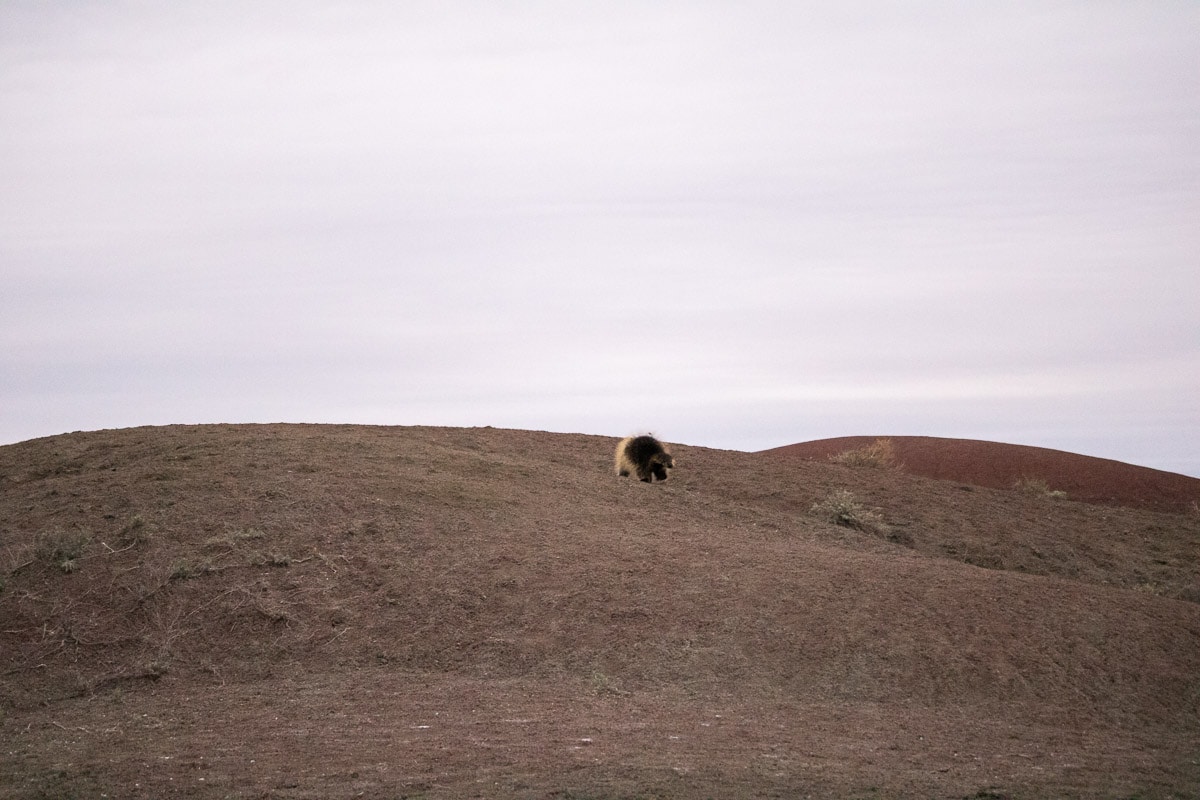
North American porcupines (Erethizon dorsatum) are semi-nocturnal herbivores that eat all kinds of plant material, from bark and twigs to seeds, leaves, berries, roots and grasses. They enjoy the varied diet provided by Badlands National Park’s prairie grasslands, shrubs and clusters of trees.
Typically seen early in the morning, late in the evening or at night, porcupines are easily recognizable by their rounded shape, slow manner of walking, and characteristic coating of quills, which can number in the tens of thousands.
In Badlands National Park, porcupines can be seen in the grasslands and around stands of trees. Look for them at dusk or dawn while driving the Badlands Loop Road or Sage Creek Rim Road.
Prairie Dogs
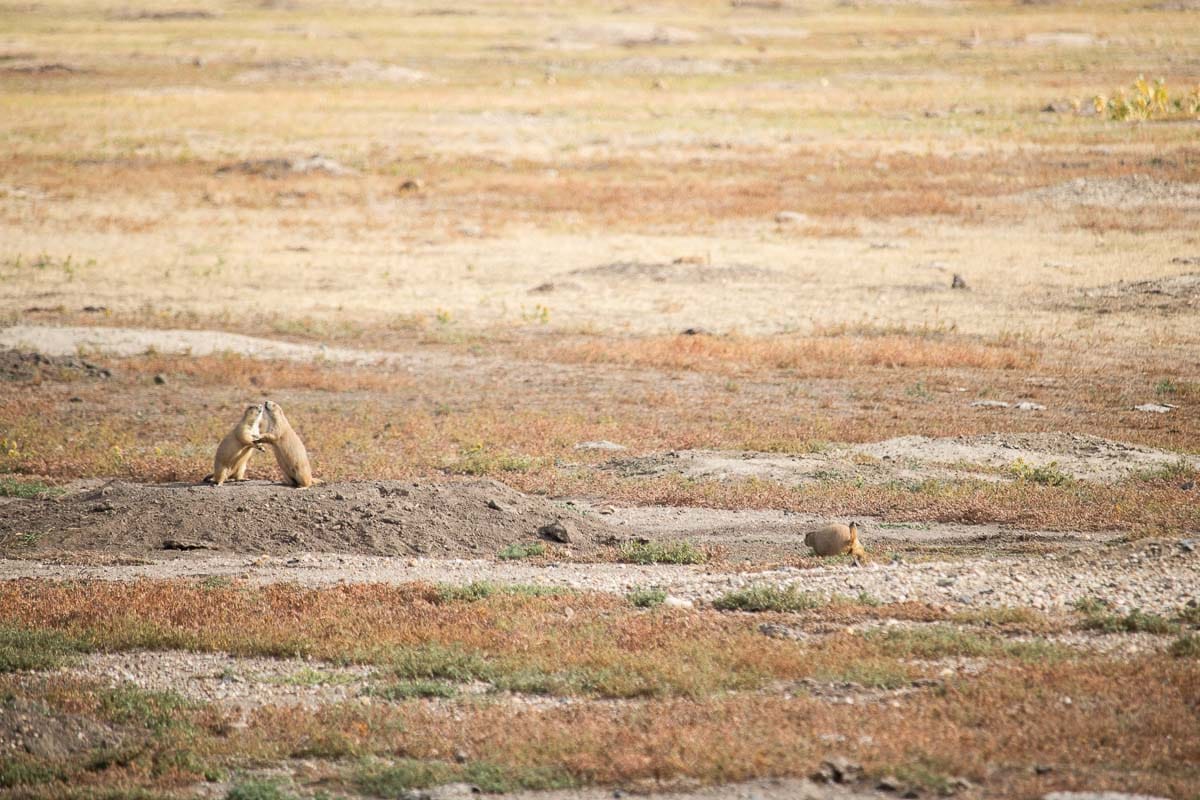
Arguably the most popular animals in Badlands National Park, black-tailed prairie dogs (Cynomys ludovicianus) are part of the squirrel family, related to chipmunks and ground squirrels.
Prairie dogs are common throughout Badlands National Park, which encompasses their historic, natural habitat—mixed-grass prairie. These industrious little mammals live in underground colonies, which are known as “towns.”
Prairie dog towns are exceptionally complex, made up of numerous entrances, passageways, food storage rooms and side chambers. These towns are divided into distinct units known as “coteries,” which are essentially neighborhoods. Each coterie encompasses approximately one acre and has 50 to 60 entrance and exit points.
Prairie dog towns can be truly enormous, often encompassing dozens of square miles. According to the National Park Service, the largest prairie dog town ever recorded was 25,000 square miles in size!
There are several prairie dog towns in Badlands National Park. Some of the best places to see these animals in Badlands are Sage Creek Campground, the Burns Basin Overlook, the Pinnacles Entrance Station and, of course, Roberts Prairie Dog Town on the Sage Creek Rim Road.
Pronghorn
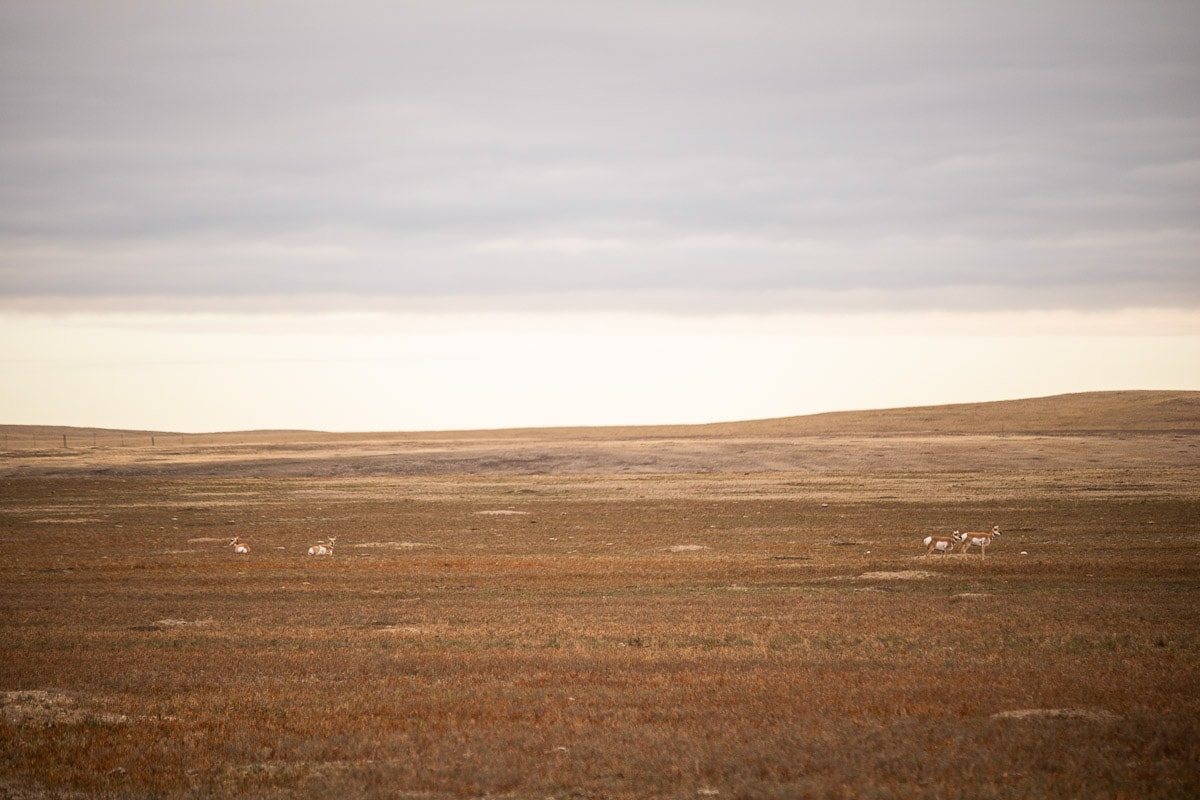
Also known as “pronghorn antelope,” the pronghorn (Antilocapra americana) is a remarkable animal that lives in the open grasslands of the American West. It’s the “only living member of the family antilocapridae and is most closely related to the giraffe,” the Park Service says.
Pronghorn are easy to recognize thanks to their brown-and-white fur and distinct prong-shaped horns. They feed on the many shrubs, forbs and grasses that grow on the plains.
The fastest land mammal in the Western Hemisphere, pronghorn can sustain speeds of up to 55 mph for half a mile. They’re able to run 45 mph for much longer distances, allowing them to escape virtually all predators on the open prairie.
You can often see pronghorn grazing and running across the grasslands in Badlands National Park.
Look for them in large areas of unbroken grasslands, particularly in the high prairie north of the Badlands Loop Road, around the Pinnacles Entrance Station and in the adjacent Buffalo Gap National Grassland.
Rattlesnakes
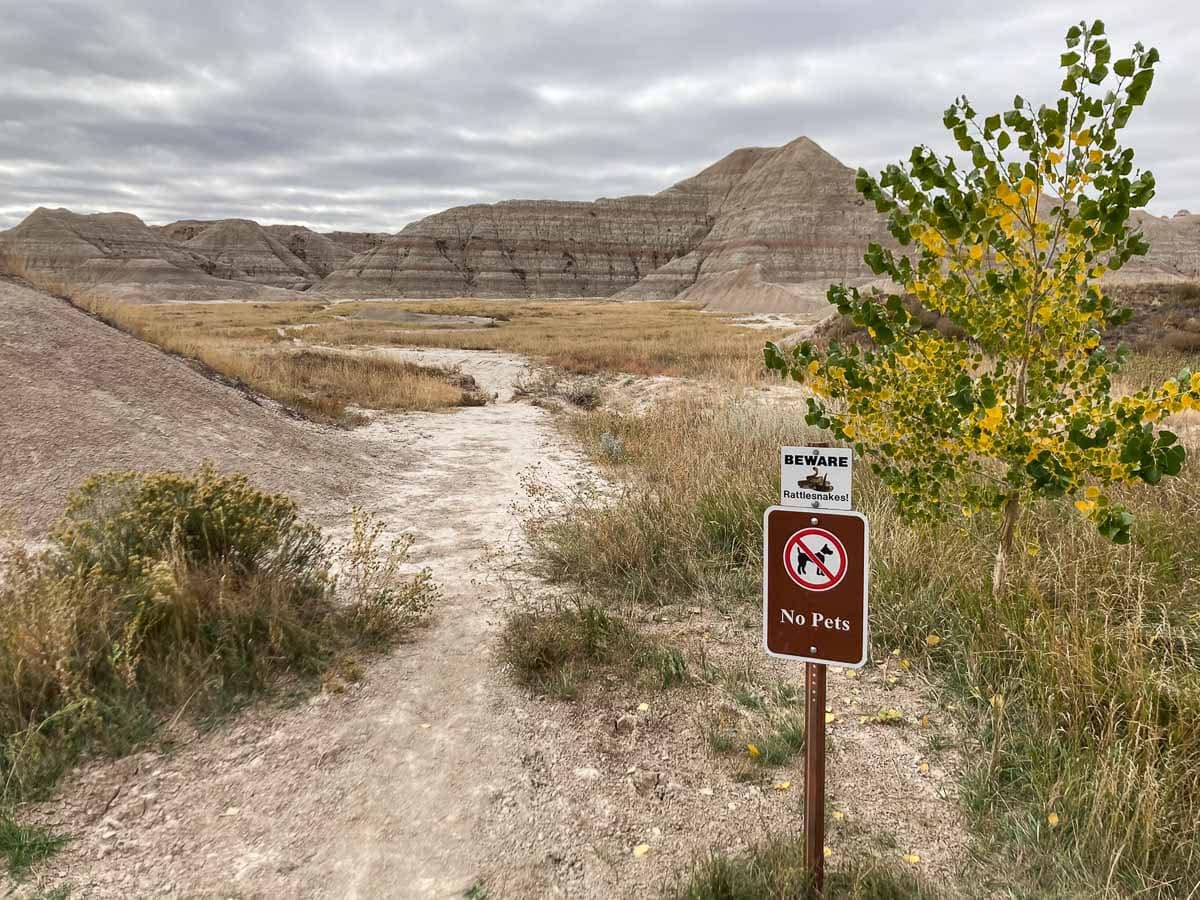
Only one species of rattlesnake lives in Badlands National Park, but it’s abundant throughout the park. This is the prairie rattlesnake (Crotalus viridis), the only venomous snake in South Dakota.
Of all wildlife in Badlands National Park, this is probably the only animal you don’t want to encounter. Yet, seeing a rattlesnake from a safe distance can be quite a memorable experience. This is a keystone species in the Badlands, after all, an integral part of the ecosystem and nothing short of an iconic Great Plains animal.
Prairie rattlesnakes thrive in these grasslands, feeding on chipmunks, rabbits, mice, ground squirrels, prairie dogs and other small animals, including birds like burrowing owls.
As such, they’re often found near prairie dog towns. You can encounter them anywhere in the park, though, including roads, the Badlands hiking trails and parking lots, which they might seek out to soak up some sunshine.
Watch out for rattlesnakes in tall prairie grass, underneath shrubs or trees, and in rocky areas. You’ll see rattlesnake warning signs throughout the park, including at basically every trailhead, boardwalk and overlook.
To avoid rattlesnake bites, always watch where you place your feet and hands. Be extra careful in areas of loose gravel, rocks and boulders, around shady trees and in tall grass. Rattlesnakes may also sunbathe in open places, including trails, roads and picnic areas. Learn about rattlesnake safety here.
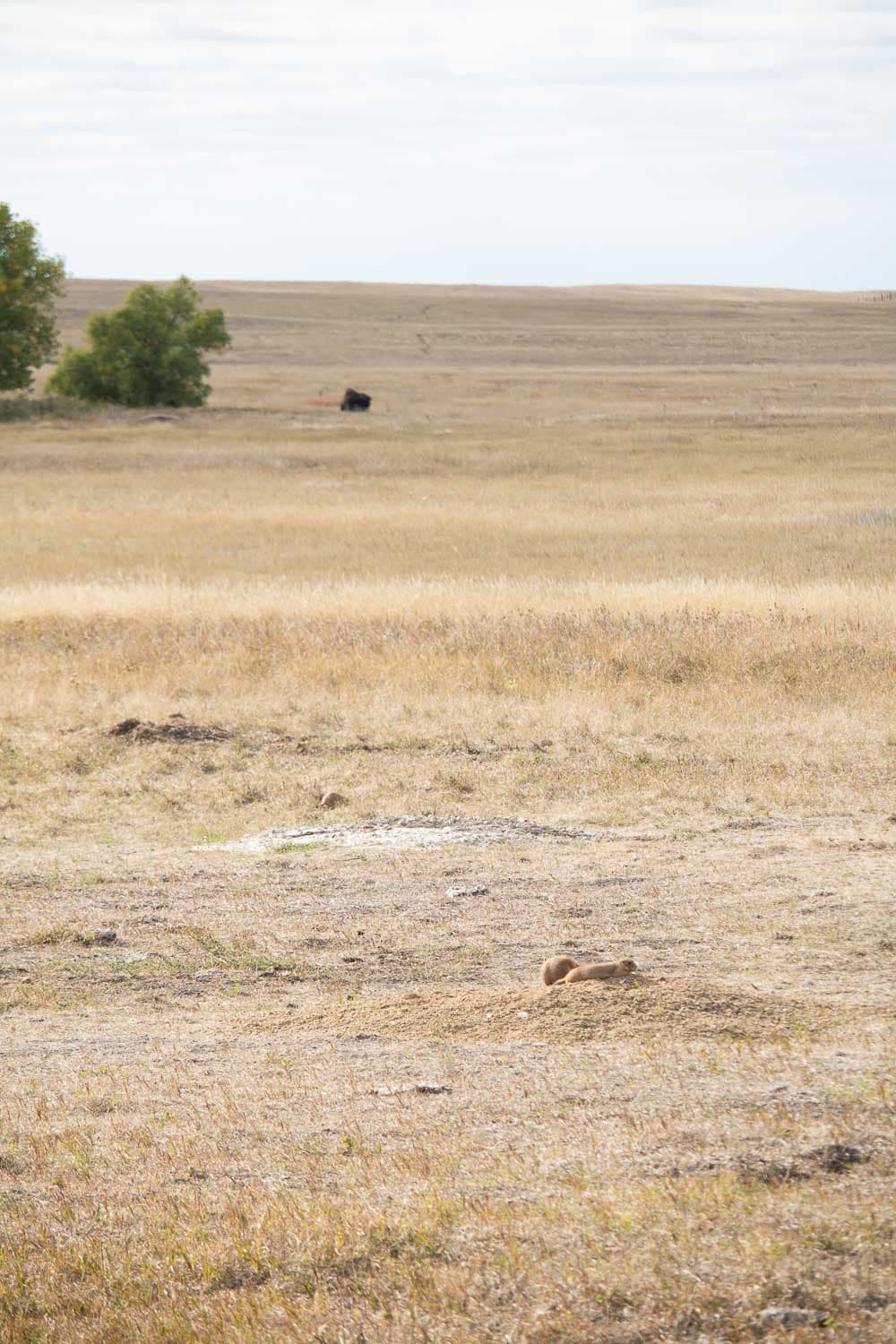
Other Iconic Animals in Badlands National Park
In addition to the Badlands National Park wildlife above, the park is home to numerous other species. Some are easier to spot than others.
Especially birds like eagles, vultures and hawks are commonly seen, while burrowing owls are quite difficult to find. Black-footed ferrets, on the other hand, are extremely rare and seeing one in the wild is a true privilege.
Mountain lions are also present in Badlands National Park, hunting mule deer and bighorn sheep, but are almost never seen. (There are no bears or wolves in the Badlands.)
Here are several other animals that live in Badlands National Park:
- Black-footed ferrets
- Striped skunks
- Chipmunks
- Mountain lions
- Burrowing owls
- Golden eagles
- Turkey vultures
- Red-tailed hawks
- …
You can see the complete list of Badlands National Park wildlife here on the park’s website.
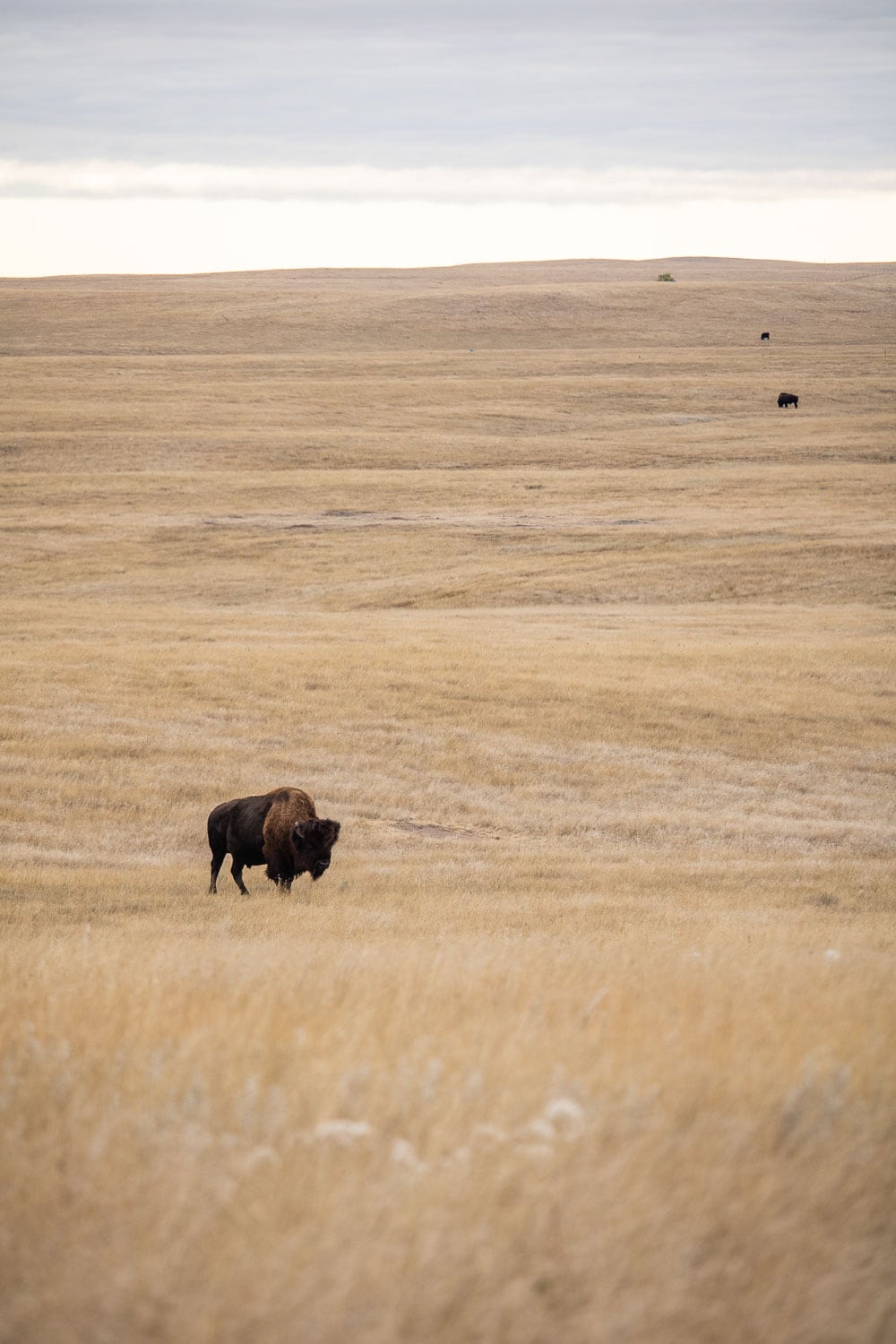
List of the Best Places to See Wildlife in Badlands National Park
Below is a list of the best places to see wildlife in Badlands National Park. You can see the most popular animals that are seen in these areas. (There are no guarantees, though. Seeing wild animals does require a healthy dose of patience and some luck.)
- Badlands Loop Road: American bison, bighorn sheep, coyotes, mule deer, porcupines, prairie dogs, prairie rattlesnakes, pronghorn, birds
- Cedar Pass: bighorn sheep, coyotes, mule deer, prairie rattlesnakes, birds
- Old Northeast Road: bighorn sheep, mule deer, prairie rattlesnakes
- Pinnacles Entrance Station: American badgers, American bison, coyotes, mule deer, prairie dogs, pronghorn
- Sage Creek Rim Road: American badgers, American bison, coyotes, mule deer, porcupines, prairie dogs, prairie rattlesnakes, pronghorn, birds


